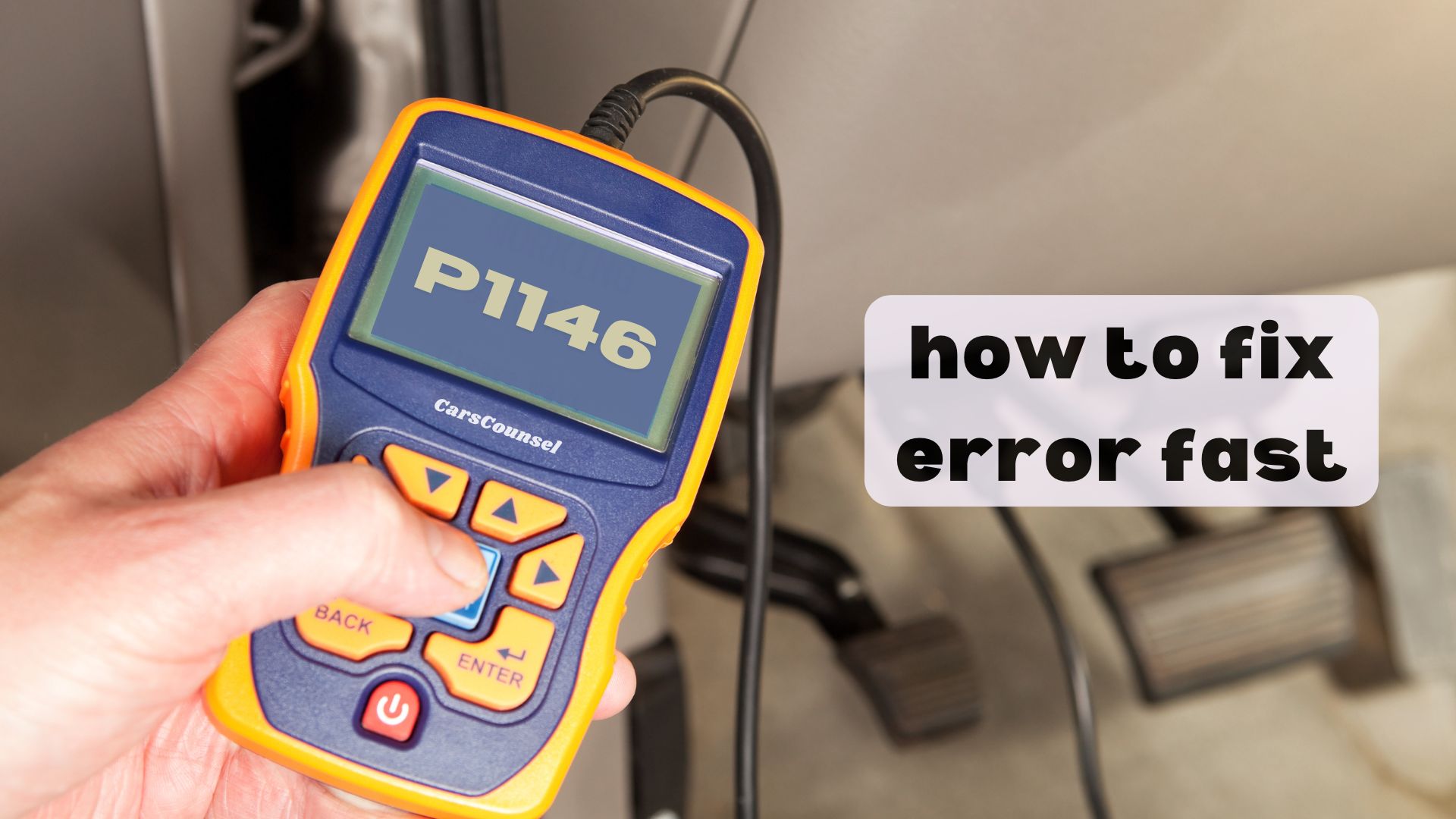When you encounter the P1146 code, it typically indicates an issue with the Heated Oxygen Sensor 2 (HO2S 2) on Bank 1, which monitors exhaust gas oxygen levels to maintain an ideal air-fuel mixture. You’ll likely face decreased fuel efficiency and increased emissions. Potential causes include a faulty sensor, wiring problems, or exhaust leaks. As you investigate this issue, you’ll need to diagnose and repair it promptly to prevent further engine and catalytic converter damage.

Quick Navigation
Key Takeaways
- P1146 code indicates issues with Heated Oxygen Sensor 2 on Bank 1.
- Faulty sensor or wiring problems can cause voltage fluctuations.
- Symptoms include decreased fuel efficiency and rough idling.
- Diagnosis involves checking voltage readings and sensor resistance.
- Repair costs range from $100 to $300 for sensor replacement.
Understanding the P1146 Code
Understanding the P1146 code involves recognizing its importance in vehicle diagnostics. This code indicates a minimum voltage reading from Heated Oxygen Sensor 2 (HO2S 2) on Bank 1, which monitors oxygen levels in exhaust gases to adjust the air-fuel mixture.
Proper sensor functionality is vital for maintaining peak engine performance. The P1146 code suggests issues with voltage readings, which can lead to decreased fuel efficiency and increased emissions.
It’s essential to address this code promptly to prevent damage to the catalytic converter and engine components.
Causes of the P1146 Code
When diagnosing the P1146 code, you’ll typically encounter issues related to the Heated Oxygen Sensor 2 (HO2S 2) on Bank 1.
Common causes include a faulty HO2S 2, wiring or connector problems, exhaust leaks, engine vacuum leaks, and ECM malfunctions.
These issues can lead to voltage fluctuations, affecting sensor calibration and overall engine performance.
Proper diagnosis involves checking for wiring damage and sensor functionality to address potential voltage fluctuations and guarantee accurate sensor readings.
Symptoms and Effects
If your vehicle is displaying the P1146 code, you’re likely experiencing symptoms that affect its overall performance.
Decreased fuel efficiency, rough idling, stalling, and engine misfires are common issues. The Check Engine Light will also be illuminated, indicating a problem with the Heated Oxygen Sensor 2‘s performance.
This can lead to reduced engine efficiency and increased emissions, potentially damaging the catalytic converter and other engine components if not addressed promptly.
Monitoring sensor performance is essential to maintaining peak engine efficiency.
Diagnosing the Issue
To diagnose the P1146 code, you’ll need to systematically check the Heated Oxygen Sensor 2 (HO2S 2) and related components.
Start by using a scan tool to confirm the code and inspect wiring and connectors for damage.
Perform sensor testing by checking voltage readings from the sensor, which should fluctuate between 0.1 and 1.0 volts for proper operation.
Use a multimeter to test the sensor’s heater element for resistance, typically between 3-25 ohms.
Check for exhaust leaks and vacuum issues that could affect sensor performance.
Testing the Heated Oxygen Sensor
Testing the Heated Oxygen Sensor 2 involves several key steps to confirm it’s functioning correctly.
First, use a multimeter to measure the sensor’s voltage output, which should fluctuate between 0.1 and 1.0 volts for a properly functioning sensor.
Next, inspect the sensor’s heater circuit for any issues, as a faulty heater can prevent the sensor from reaching operating temperature.
Ascertain proper sensor calibration by checking the voltage measurement under various engine conditions.
If the sensor fails these tests, consider replacing it to avoid further engine issues.
Repairing and Replacing Components
Repairing and replacing components related to the P1146 code involves a systematic approach to confirm the issue is resolved effectively.
You should focus on confirming sensor compatibility and checking wiring integrity. Here are key steps to follow:
- Inspect and replace the Heated Oxygen Sensor 2 if faulty.
- Verify wiring and connectors for damage or corrosion.
- Check for exhaust leaks and repair them.
- Confirm ECM functionality isn’t compromised.
- Validate sensor operation after replacement.
Cost Considerations
When addressing the P1146 code, cost considerations are essential for effective resolution.
The replacement cost for Heated Oxygen Sensor 2 typically ranges from $100 to $300. Labor costs can add $50 to $150 per hour, depending on the mechanic’s rate.
Sensor longevity is affected by factors like contamination and high temperatures, which can lead to frequent replacements. Repair costs may also include diagnostic time and potential wiring repairs.
Consulting a professional guarantees accurate estimates tailored to your vehicle’s make and model.
Prevention and Maintenance
To prevent issues like the P1146 code, maintaining your vehicle’s exhaust system and oxygen sensors is crucial. Regular maintenance can help avoid costly repairs.
Here are some preventive measures you can take:
- Regularly inspect oxygen sensor wiring and connectors for damage.
- Check for exhaust leaks that could affect sensor readings.
- Verify proper engine vacuum to prevent misfires.
- Use a scan tool to monitor sensor performance.
- Replace oxygen sensors at recommended intervals to maintain peak engine performance.
More OBD-II Codes
| P1145 | P1144 | P1143 | P1142 |
| P1140 | P1139 | P1141 | P1138 |
| P1137 | P1222 | P1221 | P1214 |
| P1213 | P1212 | P1173 | P1325 |
| P1245 | P1244 | P1243 | P1225 |
| P1224 | P1223 | P2BA8 | P2A04 |
Frequently Asked Questions
Can P1146 Affect Vehicle Safety?
P1146 symptoms like rough idling and engine misfires can affect vehicle safety. During diagnostics, inspecting wiring and testing the sensor can help resolve issues before they lead to accidents or further damage.
Is P1146 Specific to Certain Engines?
You’ll need to check engine compatibility using diagnostic tools to determine if the P1146 code is specific to certain engines, as it generally relates to oxygen sensor issues that can occur across various engine types.
Does P1146 Impact Engine Longevity?
You might think a faulty sensor won’t impact engine longevity, but it can. P1146 affects engine performance and fuel efficiency, potentially leading to increased emissions and wear on components like the catalytic converter over time.
Can P1146 Cause Engine Overheating?
You won’t typically see engine overheating directly caused by P1146. However, poor engine performance from this issue can indirectly affect overall engine health. Use diagnostic tools to assess engine performance and identify any related issues.
Is P1146 Repairable at Home?
As you tackle DIY troubleshooting, you can repair issues like sensor replacement at home. However, it requires careful inspection of wiring and connectors, and possibly replacing the faulty sensor, which can be a bit challenging without professional tools.
Conclusion
You’ve now grasped the P1146 code‘s significance, which involves issues with the Heated Oxygen Sensor 2 on Bank 1. This code can lead to decreased fuel efficiency and increased emissions due to faulty sensors, wiring, or exhaust leaks. Prompt diagnosis and repair are essential to prevent engine and catalytic converter damage. By addressing these issues, you guarantee peak engine performance and maintain environmental standards.

